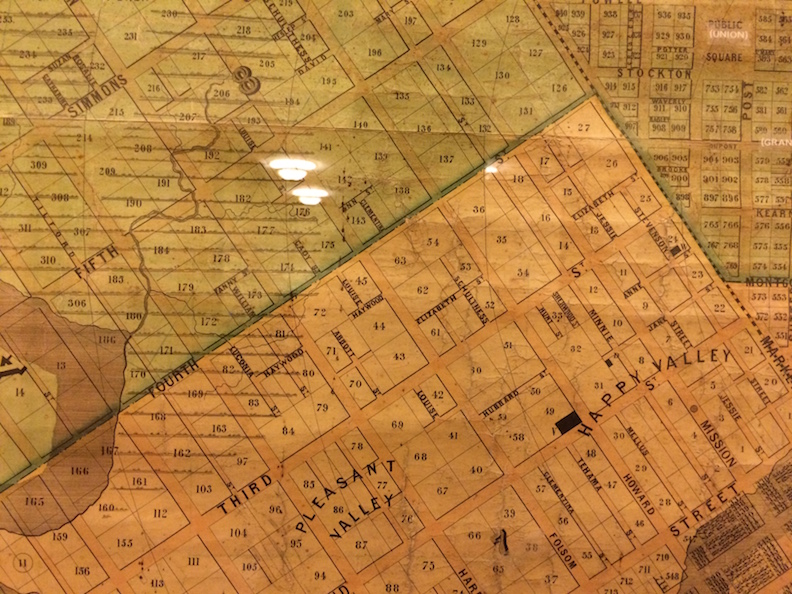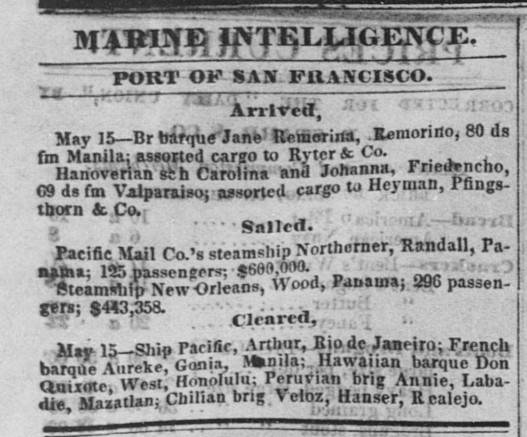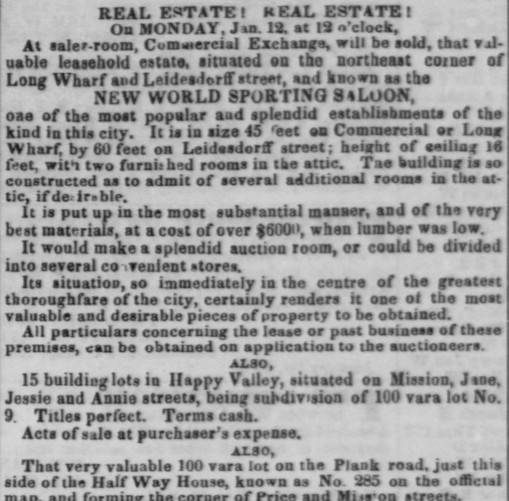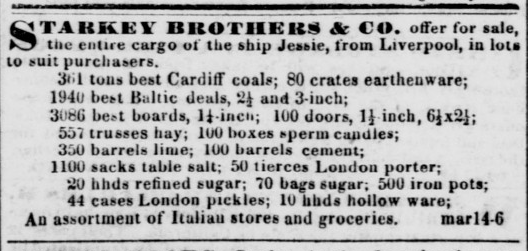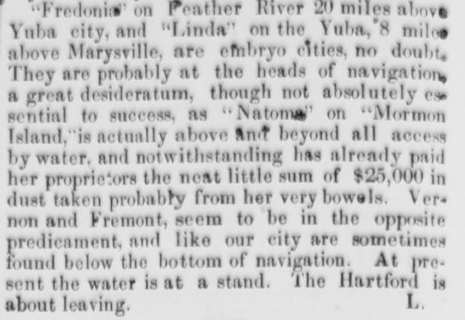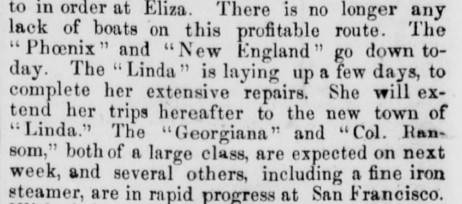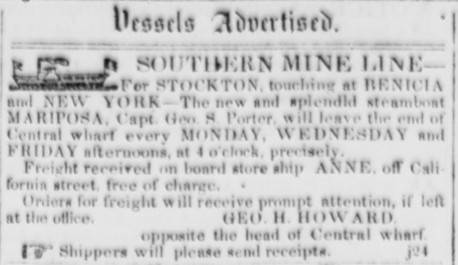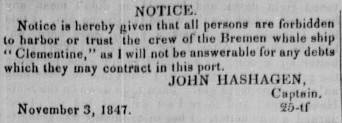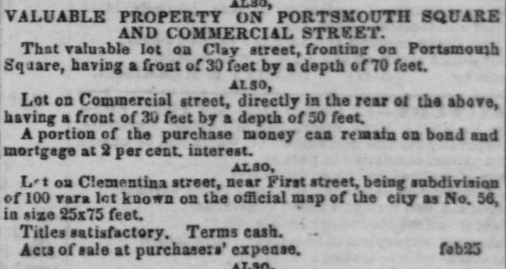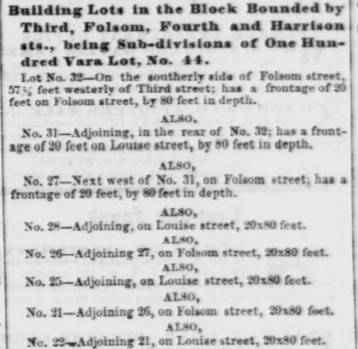SOMA Side Streets Named After Ladies
Historical Essay
by LisaRuth Elliott, 2020
Detail of 100 Vara Survey area of San Francisco (later called South of Market), on the 1854 H.F. Bridgens map.
This exploration of streets supposedly being named for women focuses on a small geographic area in San Francisco—SOMA—and a short period of time at the founding of this new urban center in the mid-19th century.
San Francisco Ladies?
"You know those streets, the back alleys, named for ladies downtown San Francisco and in SOMA? You know they were named for prostitutes, madams maybe even, during the Gold Rush and Barbary Coast days, right?!” (Wink, wink, nod, nod)
If you've ever wondered about the origin of SOMA alleys with the first names of women, you've probably heard this fancy myth, which is even part of the marketing for at least one bar along one of these streets today. There are also theories that pioneer families named them after their daughters. But, the reality is that there are very few streets named after females in San Francisco from any time period; most early streets were named after powerful men who made their mark in some way. So this is a story not only about where the street names for Jessie, Annie, Minna, Clementina, as well as their sisters Tehama and Natoma, came from, but also about the naming of things.
I find it hard to believe a street would have been named for a woman in the 1850s, and especially not for women who were likely to be transient, like sex workers. Even women who didn’t occupy the lowest rung of the ladder in terms of employment—the madams—also were mostly moving through. At the least there would be a Briones Street for Juana Briones, the most likely candidate of a woman to revere at the midpoint of the 1800s. And where are the surviving legends of the ladies to accompany the streets named for them? None have survived, if there were any. A book from 1912 says the alley names have no meaning at all.
Local historian Angus MacFarlane went on a complicated 21st century quest to prove that Haight and Waller were named after prominent women of the turn of the 19th and 20th centuries, as of course these women were married to even more prominent men with the same last names. He even had written documentation in history books to contend with, almost proving the names came from these ladies’ husbands. Even so, the streets reflect the husbands’ last names, not the given names of the women they honor.
So let’s say side streets named for the first names of women didn’t come from early ladies of the night. But what DID—and DO—people name after their female family members?
Boats! Ships!
Let’s say it is possible that these street names in SOMA might be named instead for ships. Many of the streets (alleys) in question lie on the north-south routes that would have been taken from Yerba Buena to Steamboat Point on Mission Bay along 2nd and 3rd Streets. They were also some of the first streets created in the area surveyed in 1847 and then known as the 100 Vara Survey. From Rincon Point to Steamboat Point, early SOMA was the location of the shipbuilding, shipbreaking, and steamboat reassembling industry in the mid-19th century.
But which ships would be selected? Were these streets named for early ship arrivals?
The streets we're talking about are: Annie, Jessie, Minna, Clementina, and there are Tehama, Natoma as well. There are a few that did not survive 1970s Redevelopment, and have been only preserved on very old maps, like Alice, Louise, Jane, Elizabeth, Luconia. And mixed in we have streets of a similar size like Stevenson, Shipley, Anthony, Ecker, Hubbard, Haywood, Abbott, Schultness, Mellus…not likely women’s names at all. It may also be possible that Jessie Street is not a woman’s name. Several men with the first name of Jessie appear, however, in important posts as early as 1850, but there is some notion that the street was named for Jessie Benton Frémont, wife of John Charles Frémont.
Searching the newspapers from the early 1850s for these names yielded some interesting information about boats that would support my theory, especially since William Eddy was laying out San Francisco's newly developing areas in 1851.
Sacramento Daily Union May 17, 1851 Vol. 1, No. 52
Source: California Digital Newspaper Collection
In May 1851 there was a Peruvian brig named Annie mentioned in the Sacramento Daily Union as having been cleared from the Port of San Francisco.
Daily Alta California January 6 1852, Vol. 3, No. 5
Source: California Digital Newspaper Collection
A first listing of Annie Street is made in January 1852 related to 115 lots for sale in Happy Valley, near Jane (another ship mentioned in that same Sacramento Daily Union issue above, having arrived May 15, 1851) and Mission Streets.
Daily Alta California March 14, 1851, Vol. 2, No. 95
Source: California Digital Newspaper Collection
There was a ship named Jessie which arrived in March 1851.
Daily Alta California July 3, 1850, Vol. 1, No. 159
Source: California Digital Newspaper Collection
The Tehama, a steamboat, had her first voyage in June 1850… Stockton bound.
Daily Alta California Nov. 5, 1851, Vol. 2, No. 328
Source: California Digital Newspaper Collection
By 1861 the Tehama had obviously been in frequent use, had been overhauled, and was for sale.
Daily Alta California April 8, 1850, Vol. 1, No. 85
Source: California Digital Newspaper Collection
Natoma seems to have been a gold mine/digging site near the American River where early gold was discovered, named for an indigenous tribe living along the American River. This site was located at Mormon Island (now a wetlands is named for Mormon Island). It is unclear if there might also have been a vessel named Natoma that served that point.
Daily Alta California April 8, 1850, Vol. 1, No. 85
Source: California Digital Newspaper Collection
A vessel by the name of Linda is noted in the above article as being repaired.
Daily Alta California December 15, 1850, Vol. 2, No. 6
Source: California Digital Newspaper Collection
In December 1850, Minna was being listed in the Daily Alta as the "first street below Mission" and "above First Street". It was a new street no one knew yet, so directions were being used in advertisements. Perhaps it referred to a ship that came in the early Gold Rush.
Daily Alta California June 24, 1850, Vol. 1, No. 151
Source: California Digital Newspaper Collection
The steamer Mariposa is mentioned in 1850 in the Daily Alta as having just been completed.
Californian November 10, 1847, Vol. 2, No. 26
Source: California Digital Newspaper Collection
A Clementine Street is first listed as a street in the Daily Alta in August 1850, and an article about a Bremen whaling ship Clementine—with an untrustworthy crew—can be found in the Californian at the early date of November 1847.
Daily Alta California March 1, 1852, Vol. 3, No. 60
Source: California Digital Newspaper Collection
Clementina Street may be actually first created in 1852, according to this Daily Alta article above.
Daily Alta California March 15, 1857
Source: California Digital Newspaper Collection
Louise Street is first listed in the Daily Alta concerning the subdivision of the 100 Vara lot No. 44 (betw. Third and Fourth Folsom and Harrison) in 1857.
Daily Alta California April 7, 1851 Vol. 2, No. 119
Source: California Digital Newspaper Collection
One street name is not named for a ship, but related to sea journeys. Luconia is the location of a stopping point on the voyage from China to San Francisco for a coal depot.
Unanswered questions
There is plenty of further research to do, and many more street names to investigate the origins of. An unanswered question, and one for more explanation, is why THESE particular ships, and not other ships that arrived around the same time were chosen to name streets after. Like the Don Quixote for example.
Beyond SOMA and Current Day
As mentioned at the outset, my exploration of streets supposedly being named for women focuses on a small geographic area in San Francisco and a short period of time at the founding of this new urban center. However, these are not the only street names using ladies' first, or last, names. Some streets beyond SOMA of note (but by no means exhaustive) are:
+ There is evidence that Elizabeth Street was named for a family member of early settler and Horner’s Addition owner, John Meirs Horner. The area is now known as Noe Valley. It was named for his wife, Elizabeth Imlay Horner.
+ Octavia Street was likely named after Charles Gough’s sister, as he was in charge of naming Western Addition Streets in 1855.
+ Ora Street was named after Ora Robinson, the wife of Edwin E. Robinson, the mayor of San Francisco from 1948–1956.
+ In the 1970s in Bayview Hunters Point, there were a group of women known as the "Big 5" due to their role in community organizing and fighting for funds to better their neighborhood. Today we have Osceola Lane (for Osceola Washington), Bertha Lane (for Bertha Freeman), Lillian Court, Espanola Street, and there is Westbrook Court (for Eloise Westbrook).
+ More recent streets honoring famous and inspiring women are: Isadora Duncan Lane (1988), Rosa Parks Lane (2006) and Frida Kahlo Way (2018).
Sources

